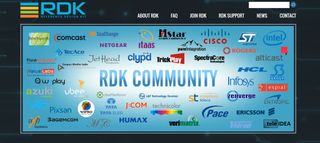Comcast’s RDK Hits the Web
Comcast’s Reference Design Kit (RDK) for client and gateway devices leans on a variety of Web standards, so perhaps it’s only fitting that the project now has its own Web site: RDK Central.
Or I should note that it has had one for a while. I just recently stumbled on it, but Comcast confirmed that it’s been live since February.
The site’s target audience appears to be the budding RDK development community – chipmakers, app developers, set-top vendors, integration specialists, and so on.
But it does a good job of explaining, at least from Comcast’s point of view, the aims of the RDK alongside some helpful tidbits in the form of video interviews with Comcast execs with Multichannel News contributor Leslie Ellis.
Boiled down, the RDK’s aim is to offer a royalty-free, pre-integrated bundle of software that can accelerate the product development cycle of IP and hybrid QAM/IP clients and gateways. It’s also designed to “treat consumer-purchased devices as first-class citizens in the cable ecosystem,” a move that would seemingly let Comcast jump on the innovation wave being created by retail video device market.
This decoupling from the hardware is supposed to help Comcast and its set-top partners also pick up the pace of innovation on a platform that has historically been slow in that regard. According to site documentation, RDK releases with new features occur on a quarterly cycle, with other releases (bug fixes, etc.) occurring monthly.
Although the Open Cable Application Platform (OCAP) reference implementation is in the RDK, the RDK is not middleware, Comcast insists. And that’s good news for everyone who recalls how much of a dud OCAP (a.k.a. tru2way) was as a sparker of retail innovation.
The RDK is "the anti-middleware, actually,” Mark Hess, a Comcast SVP, notes in one of the videos. “It’s not code; it’s not a spec. It’s not cable specific. It’s not something only our device can use. It’s more of a glossary of different Web modules…” Some of those include QTWebkit and GStreamer.
Comcast’s new X1 service is the first to utilize the RDK, which supports third-party plug-ins, allowing it to use Web-facing apps such as Pandora and Facebook, and potentially open the door to a bunch more.
More than 80 companies have signed the RDK license, so the development community is gathering. But getting on board with Comcast apparently takes another step. The site also mentions that anything created specifically for the MSO requires a separate Comcast Proprietary Component (CPC) licensing agreement. So there’s that.
And while Comcast has gotten this effort off the ground, we’re still waiting to find out when other MSOs will adopt it, and how quickly they intend to implement it.
Liberty Media, Charter Communications and Time Warner Cable have previously been linked to the RDK in some shape or form. The RDK site also shows Canada’s Rogers Communications and Japan’s J:COM as being part of the “RDK Community,” so there appears to be some additional MSO activity happening in the background.

One place to anticipate more clarity on that front is at next week's Cable Show in Washington, D.C. If the RDK is on your company’s agenda, or will be soon, here are a couple of don’t miss sessions:
- The CTO panel on Monday at 2 p.m. ET (room 207B), which promises to offer some discussion on the RDK. Scheduled speakers include Cox's Kevin Hart, Cablevision's Yvette Kanouff, TW Cable's Mike Lajoie, and Comcast's Tony Werner.
- The “RDK in Action” session on Wednesday at 1:45 p.m. ET at Imagine Park (Booth 2133).That one will offer some perspective from RDK licensees and vendors such as Tata Elxsi, Espial, Humax, Hillcrest Labs, and Symphony Teleca.
Multichannel Newsletter
The smarter way to stay on top of the multichannel video marketplace. Sign up below.



